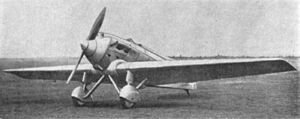IAR CV-11
| IAR CV 11 | |
|---|---|
 |
|
| Role | Fighter |
| National origin | Romania |
| Manufacturer | IAR (Industria Aeronautică Românǎ) |
| Designer | Elie Carafoli |
| First flight | 1930 |
| Introduction | never |
| Primary user | Romania |
| Number built | 2 |
The IAR CV 11 was a Romanian fighter prototype in 1930, designed by Elie Carafoli, and it was IAR's first original aircraft.
In early 1930 a contest was called by the ARR for a new fighter type to equip its squadrons. During July and October, seven foreign types were tested at an airfield near Bucharest. No decision was made, however, since none of the contenders reached the minimal speed limit set by the requirements at 300 km/h. Despite the inconclusive results, the favourite plane seemed to be the chunky-looking Polish P.Z.L. P.1/II prototype, registered SP-ADO. During the same period, the air force commission was informed that a new fighter prototype had been completed at I.A.R., and it had reached an impressive 319 km/h top speed during initial test flights.
Built according to the plans of Dipl.-Eng. Dr. Elie Carafoli and Lucien Virmoux, the I.A.R. fighter was an advanced construction. Named the C.V. 11 after its designers, it had a mixed metal-wood structure and cantilever, low-wing configuration, modern features soon to be adopted by all major aircraft manufacturers. The front fuselage structure was made of duraluminum tubes, while the rear part was of pinewood. The engine nacelle and the fuselage up to the cockpit were covered by duraluminum sheets, the aft part by plywood. The rear part of the fuselage merged with the tail without a substantial cross-sectional change, giving the aircraft a rather unusual arrow-like look. Due to its unconventional fuselage configuration the overall length came to less than 7 m, while the height was only 2.46 m. The 11.50 m span wing was made up by three sections of combined duraluminum/pinewood construction,reinforced by steel cables. The centre part housed the main wing fuel tank. The unbalanced control surfaces, which proved to be too small during trials, were made entirely of wood covered by fabric.
The powerplant chosen was a Lorraine-Dietrich 12Fa Courlis with 12 cylinders arranged in a W configuration. Its maximum output was an impressive 600 h.p. (447 kW) but it proved to be too heavy for the small and light fuselage, which weighted only 1,100 kg, and caused a dangerous tendency to go into a spin at low speed. This shortcoming could not be eliminated, so the prototype, officially designated I.A.R. C.V. 11/W.8, had finally to be abandoned.
In the meantime, a second prototype was completed at I.A.R. This time a less powerful but sensibly lighter Hispano-Suiza 12Mc engine, with 12-cylinders in V, had been fitted to essentially the same fuselage. Although weaker than its predecessor, this engine gave a superior maximum speed of 328 km/h at sea level and 295 km/h at 5,000 m.
...
Wikipedia
